Getting your garden's light levels right is essential for healthy plant growth. You'll need to match each plant's specific requirements: full-sun plants need 6+ hours of direct sunlight, while shade plants thrive with less than 4 hours. Use a light meter to measure exposure throughout your space, and consider LED grow lights for areas that need a boost. Understanding your garden's light patterns will help you create the perfect environment for your plants to flourish.
Understanding Plant Light Requirements
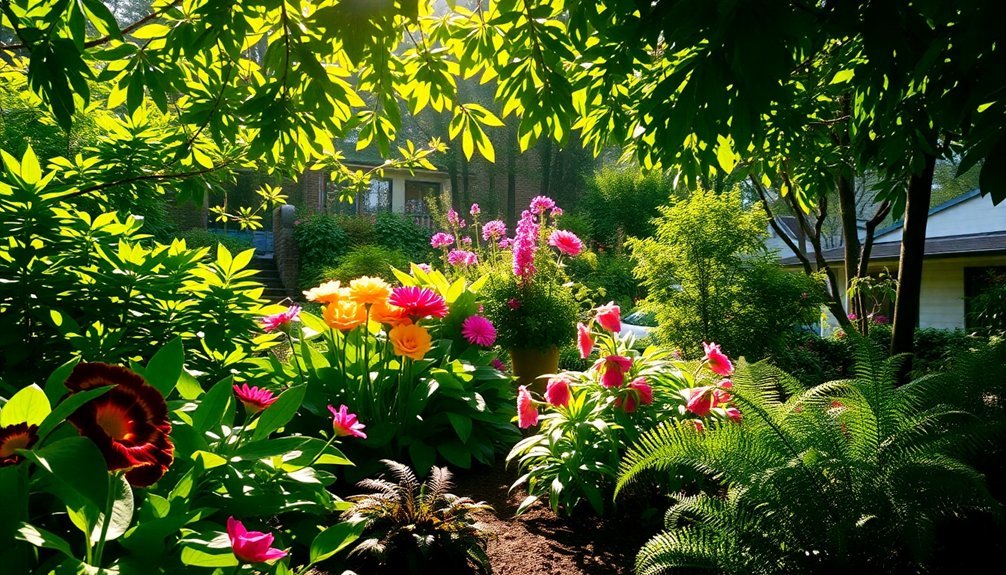
When planning your garden, understanding plant light requirements is crucial for successful growth and vibrant blooms. Different light levels dictate where your plants need to be placed for ideal health.
Full sun plants thrive in open spaces, requiring at least 6 hours of direct sunlight daily. If you've got spots that get 4 to 6 hours of sun, you'll want to choose part sun plants for afternoon exposure or part shade plants for morning light.
For those shady corners receiving less than 4 hours of direct sunlight, full shade plants are your best choice. They'll flourish in filtered or dappled light conditions.
To make the right plant selections, take time to observe your garden's sun patterns or use a light meter to measure exposure accurately. This careful assessment guarantees your plants will thrive in their chosen locations.
Measuring Garden Light Intensity
Three key methods can help you accurately measure your garden's light intensity. Using a light meter provides precise readings in lux or foot candles, while tracking hourly sun exposure helps you understand light patterns throughout the day.
You'll want to monitor and record the amount of light in different garden areas, especially after trees have fully leafed out for accurate results.
- Take measurements at various times during the day to capture changing light conditions
- Compare readings to plant requirements (100-200+ foot candles for most plants)
- Document low-light areas where shade-tolerant species (50-75 foot candles) might thrive
- Calculate average light exposure to match plants with suitable locations
This data-driven approach guarantees you'll select plants that match your garden's specific light conditions, setting them up for successful growth and development.
Types of Artificial Grow Lights
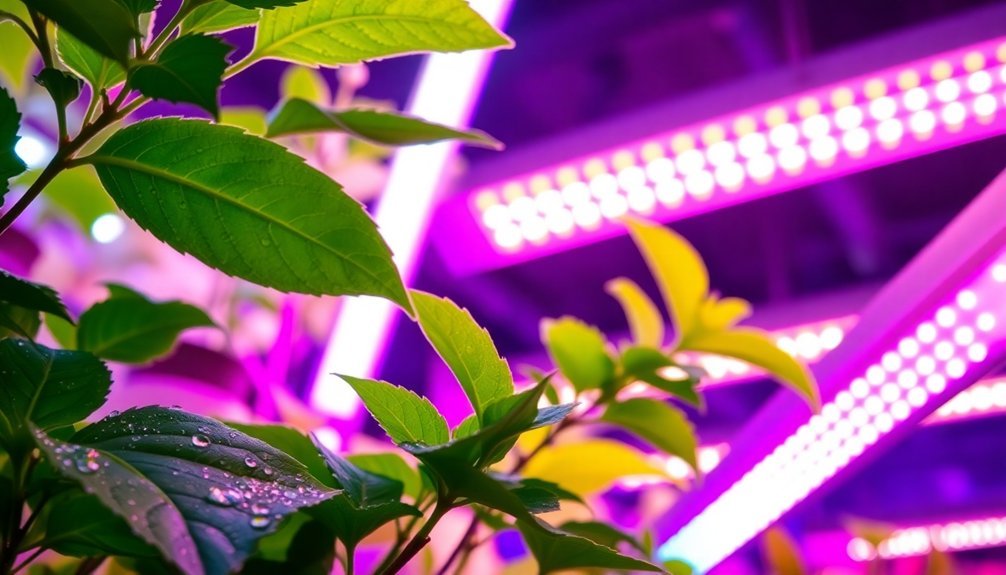
Your indoor garden can thrive with LED grow lights, which offer unmatched energy efficiency by using 90% less electricity while lasting up to 30,000 hours.
When you're choosing between grow light options, consider that HID lights like High-Pressure Sodium and Metal Halide provide specific benefits. HPS excels in flowering phases while Metal Halide promotes strong vegetative growth.
For starting seedlings or maintaining leafy plants, you'll find fluorescent lights particularly effective, as they provide a broad light spectrum at a lower cost than other options.
LED Growing Light Benefits
LED grow lights have revolutionized indoor gardening by offering unmatched efficiency and versatility compared to traditional lighting options.
You'll find that LED bulbs use 90% less energy than incandescent lights while providing full-spectrum artificial light that perfectly mimics natural sunlight. With a lifespan of over 30,000 hours, they're a long-lasting solution for your indoor garden.
- Customizable light settings let you adjust spectrum output for different plant types and growth stages
- Significant reduction in electricity costs through superior energy efficiency
- Minimal heat output makes them safe to place close to plants
- Ideal for spaces with limited natural light, enabling year-round growing
When you choose LED grow lights, you're investing in technology that delivers excellent growing conditions while being environmentally friendly.
Their precision and reliability make them ideal for serious indoor gardeners.
HID Light Performance Comparison
While LED technology has gained popularity, High-Intensity Discharge (HID) lights remain a powerful choice for large-scale indoor growing operations.
These lighting fixtures come in two main varieties: Metal Halide (MH) and High-Pressure Sodium (HPS), each serving distinct growth phases.
You'll find MH bulbs excel during vegetative growth, producing white light that mimics natural daylight, though you'll need to wait up to 20 minutes for full brightness.
HPS bulbs, on the other hand, deliver red-rich spectrum that's perfect for flowering and fruiting, with better energy efficiency than their MH counterparts.
Before choosing HID lights, consider their limitations.
They'll require replacement more frequently than LEDs, lasting only 10,000 to 20,000 hours.
You'll also need to invest in cooling systems to manage the significant heat they generate.
Fluorescent Light Applications
Three key advantages make fluorescent grow lights a practical choice for indoor gardening: affordability, low heat output, and balanced light spectrum.
You'll get reliable plant growth for 7,000 to 15,000 hours, making them perfect for short-term growing projects and seedling development.
- T5 bulbs offer superior energy efficiency and higher light output compared to T8 options.
- Place plants closer to the light source without worrying about heat damage.
- Choose cool white bulbs for vegetative growth phases.
- Select warm white bulbs to support flowering stages.
Whether you're starting seeds or growing leafy greens, fluorescent lights provide the right balance of light frequencies for healthy development.
While they may not last as long as LEDs, they're an excellent choice for beginners and experienced gardeners who need dependable lighting without breaking the bank.
Optimal Light Placement Strategies
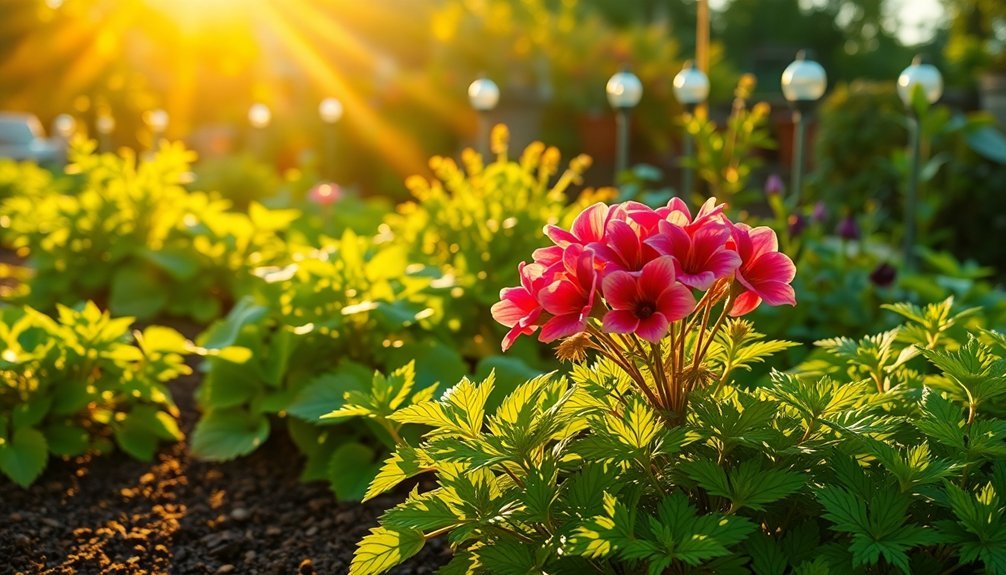
Your garden's lighting success depends on smart fixture positioning, with ambient lights at entry points (50-100 lux) and task lighting placed 6-10 feet high near access areas.
You'll want to create distinct lighting zones using fixed fixtures like wall-mounted lights and bollards (10-30 lux) along pathways, while strategically positioning accent lighting to highlight focal points.
To prevent dark spots, you should incorporate recessed or strip lighting for steps and walkways, ensuring continuous illumination throughout your garden's key areas.
Strategic Fixture Positioning
Strategic fixture positioning requires careful planning to maximize both functionality and aesthetic appeal in your garden lighting design.
You'll want to mount outdoor fixtures between 6-10 feet high for ideal pathway illumination while preventing glare. For consistent coverage, space your garden lights 8-10 feet apart along driveways and walkways, maintaining illumination levels of 10-30 lux.
- Install full cutoff fixtures to direct light downward, reducing light pollution and enhancing garden safety.
- Position security lights with PIR sensors near entry points for automated, energy-efficient protection.
- Place accent lighting strategically to highlight garden focal points like statues or specimen plants.
- Confirm pathway fixtures provide overlapping light coverage to eliminate dark spots and maintain consistent illumination.
These positioning strategies will create a well-lit, secure, and visually appealing outdoor space.
Zone-Based Light Distribution
Effective garden lighting starts with dividing your outdoor space into distinct zones, each requiring specific illumination levels for ideal functionality and atmosphere. You'll want to select light bulbs that provide the right brightness for each area's purpose.
| Zone Type | Recommended Lux |
|---|---|
| Pathways | 10-30 lux |
| Entry Points | 50-100 lux |
| Backyard Areas | 20-50 lux |
| Task Areas | 75-150 lux |
Start by illuminating pathways with subtle lighting to prevent trips and falls. Entry points need bright light for security, while your backyard can feature softer illumination for a relaxing ambiance. Don't forget task-specific zones like garages, which require stronger lighting for visibility. Layer your lighting by combining ambient, task, and accent fixtures to create depth and visual interest throughout your garden zones.
Minimizing Shadow Areas
While shadows can add drama to garden design, unintended dark spots can create safety hazards and diminish the overall appeal of your outdoor space. To effectively minimize shadow areas, you'll need to strategically position lighting fixtures throughout your garden.
Mount downlights and spotlights at heights between 6-10 feet to guarantee even illumination across your landscape.
- Install full cutoff fixtures to direct light downward and prevent unwanted shadows from plants and structures.
- Place recessed or in-ground lighting along pathways and edges to brighten dark corners.
- Divide larger gardens into zones, using targeted task lighting with overlapping coverage.
- Monitor your garden's lighting at different times to identify and address persistent shadow areas.
Remember to regularly assess your lighting setup and adjust fixture placement as your garden grows and changes throughout the seasons.
Light Duration and Plant Growth
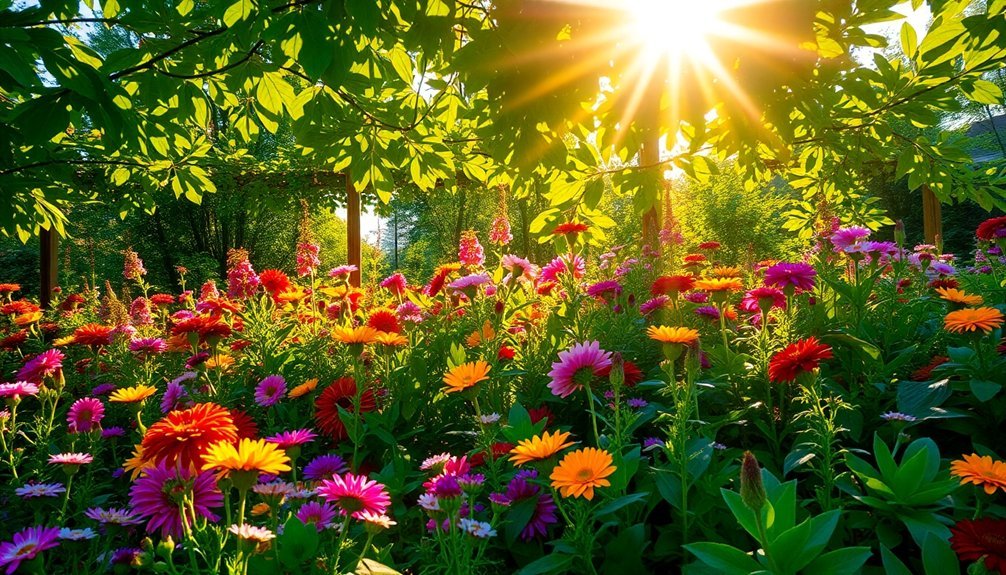
Understanding how long to expose your plants to light is just as essential as providing the right light intensity. Most indoor plants need light for 12-16 hours daily to flourish, followed by a vital dark period for rest and regeneration.
Your plants' specific light duration requirements depend on their type. Short-day plants thrive with less than 12 hours of exposure, while long-day plants need more than 14 hours. Day-neutral plants aren't picky about light duration, making them easier to maintain.
If you notice leggy growth or reduced flowering, your plants likely aren't getting enough light time. Conversely, excessive exposure can stress your plants and burn their leaves.
You'll get the best results by installing timers for your artificial lights, ensuring consistent daily exposure that mimics natural patterns.
Color Temperature for Plant Success
Beyond the duration of light exposure, color temperature shapes how your plants grow and develop. The quality light you provide determines whether your plants will focus on vegetative growth or flowering.
You'll want to match your light's color temperature to your gardening goals.
- Cool temperatures (5000K-6500K) boost leaf production and photosynthesis in herbs and greens
- Warm temperatures (2700K-3000K) encourage flowering and fruit development
- Full-spectrum LEDs (3000K-6500K) mimic natural sunlight for overall plant health
- Blue light (4000K-5000K) promotes strong stem and leaf growth
Signs of Light Level Problems
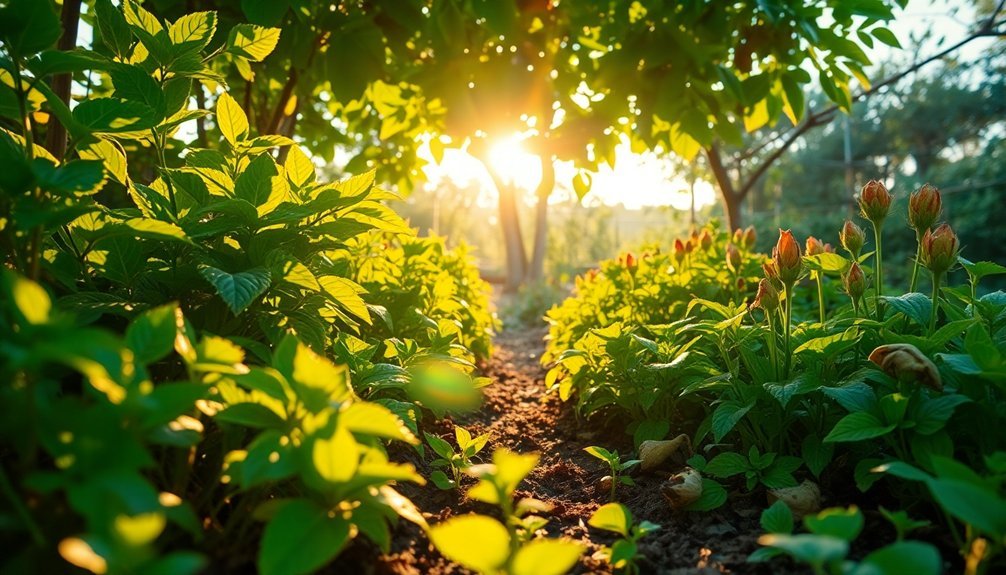
How can you tell if your plants aren't getting the right amount of light? Your garden will show clear warning signs when light levels aren't ideal.
Watch for leggy plants stretching toward light sources, which indicates they need much light. If you notice yellowing leaves, your plants might be struggling to photosynthesize due to insufficient brightness.
Leggy stems and yellow leaves are clear distress signals from plants desperately seeking more light for survival.
Pay attention to flowering plants that produce fewer blooms or fail to flower altogether, as this often signals inadequate light exposure.
Plants with unusually dark green leaves combined with slow growth may actually be suffering from too much shade.
Additionally, if your plants appear stunted or show minimal growth, especially sun-loving varieties, they're likely telling you they need more light.
These visual cues help you identify and correct light-related issues before they become serious problems.
Seasonal Light Adjustments
Just as plants signal their light needs through visible symptoms, they also require different light levels throughout the year.
Seasonal changes dramatically impact your garden's lighting conditions, with summer offering abundant sunlight and winter bringing limited exposure.
You'll need to monitor and adjust your garden's layout to guarantee plants receive adequate light year-round.
Here's what you can do to optimize light exposure:
- Use a light meter to measure sun exposure in different garden spots throughout seasons
- Track sunlight patterns and angles to identify prime growing areas
- Relocate container plants closer to windows or brighter spots during darker months
- Adjust plant placement based on seasonal light requirements, especially for sun-loving varieties
Understanding these seasonal fluctuations helps you create a thriving garden environment that adapts to nature's lighting rhythm.
Light Requirements by Growth Stage
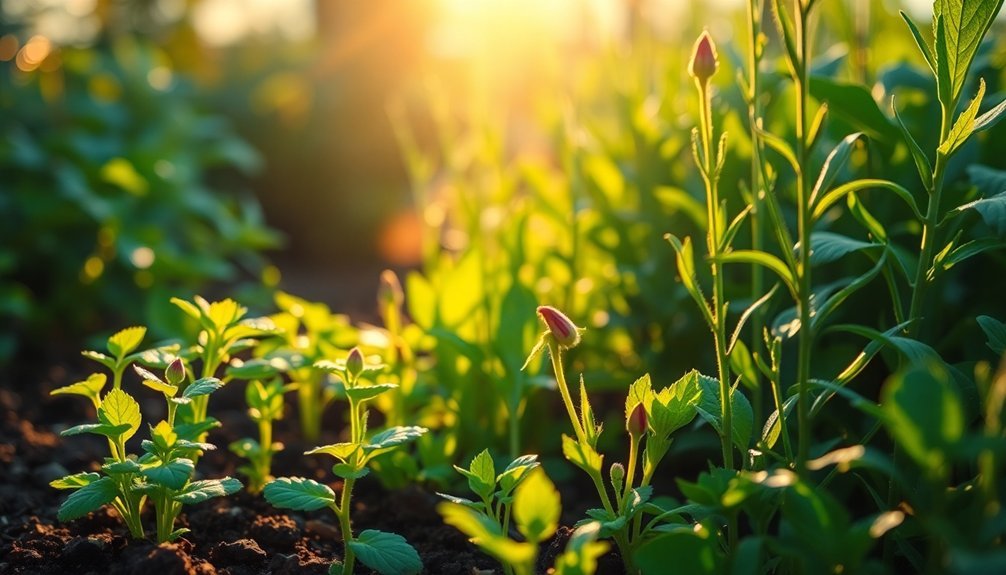
Your plants' lighting needs shift dramatically throughout their lifecycle, starting with seedlings requiring gentle illumination at 100-200 foot candles to prevent stress.
During the vegetative phase, you'll need to increase light intensity to 200-400 foot candles to support robust leaf development and overall plant health.
As your plants enter the flowering stage, they'll thrive with bright light levels between 400-600 foot candles, which helps maximize flower production and fruit development.
Seedling Stage Light Needs
When seedlings first emerge, they need specific light conditions to develop into strong, healthy plants.
You'll want to provide 12-16 hours of bright, indirect light daily to prevent stretching and guarantee robust growth. The ideal light intensity for your seedlings falls between 100-200 foot candles, which you can achieve using LED or fluorescent grow lights.
Keep these essential points in mind for peak seedling growth:
- Position your lights 2-4 inches above the plants to maintain proper light intensity without causing heat stress
- Use a light spectrum that combines blue and red light for balanced development
- Provide consistent lighting for 12-16 hours each day
- Gradually increase light intensity as seedlings mature to prepare them for outdoor conditions
Following these guidelines will help guarantee your seedlings develop into vigorous, garden-ready plants.
Vegetative Growth Requirements
Plants entering the vegetative growth stage require markedly higher light intensities than during their seedling phase. You'll need to provide 150-300 foot candles of light to guarantee ideal growth and robust leaf development.
Different crops have varying light requirements during vegetative growth. If you're growing lettuce or spinach, aim for 100-200 foot candles, while tomatoes and peppers thrive with 300-400 foot candles.
To support healthy development, your plants need 14-18 hours of bright, indirect light daily. Pay special attention to the light spectrum – blue light between 400-500 nm is essential for strong stems and lush foliage.
Don't forget to use a light meter to monitor exposure levels regularly. This helps prevent common problems like leggy growth and guarantees your plants receive the right amount of light for their specific needs.
Flowering Light Intensity
Moving beyond the vegetative stage, flowering brings new light requirements that can make or break your garden's success. Most flowering plants thrive in full sun conditions, needing at least 6 hours of direct sunlight daily.
You'll want to guarantee your plants receive light intensities between 200-400 micromoles/m²/s (PPFD) for ideal blooming.
If you're growing indoors, full-spectrum LED grow lights can effectively mimic natural sunlight, providing the essential wavelengths your plants need to produce vibrant flowers.
- Monitor your plants' light exposure daily to prevent poor blooming
- Adjust light intensity based on specific plant requirements
- Consider that some plants may need part sun (4-6 hours) rather than full sun
- Use light meters to maintain ideal PPFD levels throughout the flowering stage
Energy-Efficient Lighting Solutions
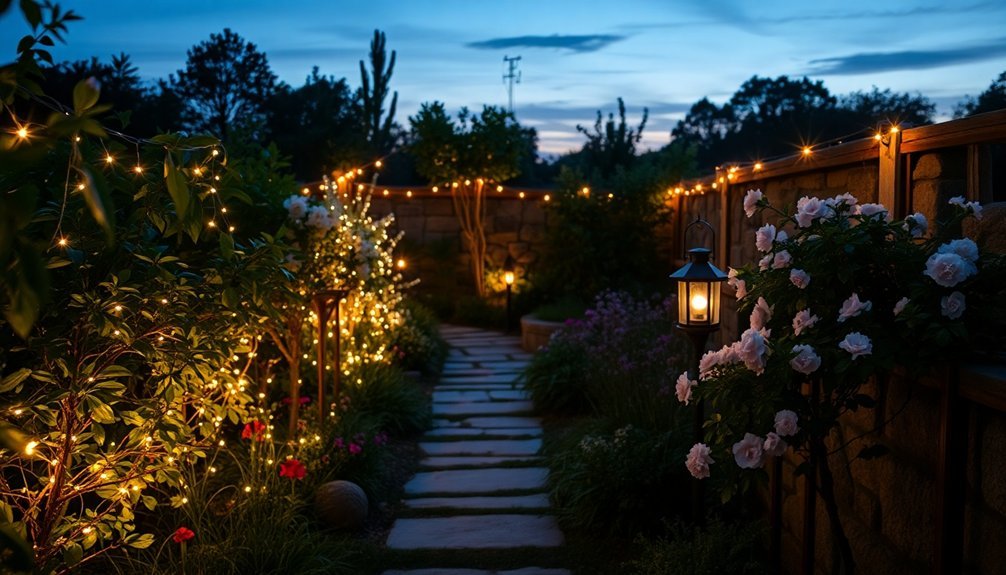
As garden enthusiasts increasingly prioritize sustainability, energy-efficient lighting solutions have become essential for modern landscape design. You'll find that LED bulbs offer the most cost-effective option, using 90% less energy while lasting longer than traditional alternatives. Solar-powered fixtures provide an eco-friendly solution that eliminates wiring needs and operating costs.
| Lighting Type | Key Benefits | Warm-up Time | Energy Savings | Lifespan |
|---|---|---|---|---|
| LED | Highest efficiency | Instant | 90% | Longest |
| Solar | No operating costs | N/A | 100% | 5-7 years |
| Metal Halide | Bright output | 20 minutes | 65% | 15,000 hours |
| Smart Systems | Automated control | Instant | 75% | Varies |
| Full Cutoff | Minimizes light pollution | Instant | 80% | Fixture-based |
For maximum efficiency, combine LED technology with smart systems and proper shielding to direct light precisely where needed.
Common Light Level Mistakes
While many gardeners focus on selecting attractive fixtures, they often overlook proper light level distribution in their outdoor spaces.
You'll want to avoid these common mistakes that can impact both your garden's functionality and the environment.
- Installing too many bright lights creates light pollution and disrupts local wildlife, while inadequate lighting leaves dangerous dark spots.
- Failing to follow recommended light levels (10-30 lux for driveways, 50-100 lux for front yards) compromises safety and visibility.
- Overlooking energy efficiency leads to excessive electricity costs and increases your carbon footprint.
- Neglecting maintenance reduces fixture performance and longevity.
Remember that finding the right balance is essential.
You'll need to provide adequate illumination for safety and aesthetics while being mindful of energy efficiency and environmental impact.
Regular maintenance of your lighting system guarantees peak performance and longevity.
Plant-Specific Light Charts
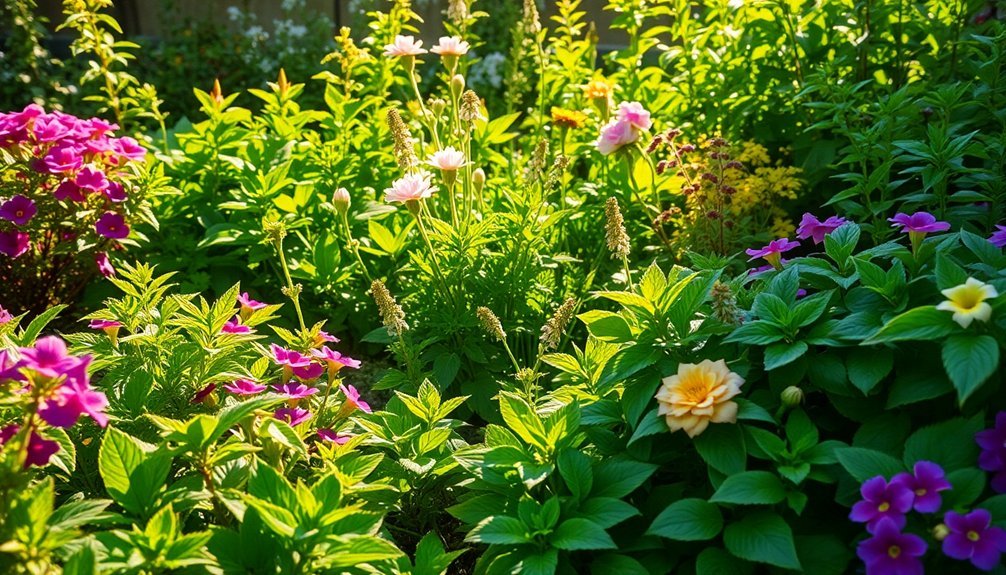
Understanding your plants' specific light requirements is essential for their survival and growth.
You'll find that full sun plants need at least 6 hours of direct sunlight daily, while full shade varieties thrive with less than 4 hours. Part sun plants fall in between, requiring 4 to 6 hours of direct light.
Before placing your plants, check their tags for precise light requirements. Sun-loving plants like succulents and tomatoes won't perform well in shady spots, leading to stunted growth and poor flowering.
Smart Lighting Technology
Modern smart lighting technology brings garden illumination into the digital age.
You'll discover unprecedented control over your outdoor lighting through smartphone apps and voice commands, making energy efficiency more accessible than ever. These systems adapt to your needs, automatically adjusting to ambient light levels and weather conditions.
Key features of smart lighting technology include:
- Motion-activated illumination that enhances security while reducing unnecessary power usage
- Customizable schedules that automate your lighting based on daily routines
- Adjustable brightness and color temperature settings for different occasions
- Integration with weather monitoring systems to optimize performance during various conditions
Whether you're hosting an outdoor gathering or simply want to enhance your garden's nighttime appeal, smart lighting technology offers the perfect blend of convenience, efficiency, and customization.
You'll save energy while maintaining the perfect ambiance for any occasion.
Frequently Asked Questions
How to Determine the Amount of Sunlight Your Garden Gets?
You'll need to observe your garden throughout the day, tracking direct sunlight hours. Use a light meter for precise measurements, and note any structures blocking light. Consider seasonal changes when planning your garden.
Do Grow Lights Really Work?
Yes, grow lights really work! You'll see significant results when using full-spectrum LED lights that mimic natural sunlight. They're proven to support photosynthesis, promote healthy growth, and let you garden successfully indoors year-round.
How to Get More Sunlight to Garden?
You can increase garden sunlight by pruning overhanging branches, moving tall plants, using reflective surfaces like white fences, and installing grow lights. Track sun patterns to identify and optimize light-receiving areas for your plants.
What Direction Should a Garden Face?
You'll get ideal growing conditions with a south-facing garden for maximum sunlight. If that's not possible, east-facing gardens offer good morning light, while west and north orientations work for shade-tolerant plants.
In Summary
Now you're equipped to make informed lighting decisions for your garden. Remember, you'll get the best results by matching each plant's light requirements, monitoring intensity levels, and adjusting placement seasonally. Don't be afraid to experiment with different lighting solutions, but always track your results. Whether you're using natural light, artificial grow lights, or a combination, you've got the knowledge to help your garden thrive.





Leave a Reply